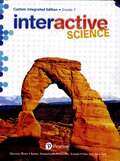- Table View
- List View
Interactive Science [Grade 7]
by Michael J. Padilla Don Buckley Zipporah MillerNIMAC-sourced textbook
Interactive Science [Grade 7] Texas
by Michael J. Padilla Don Buckley Zipporah MillerNIMAC-sourced textbook
Interactive Science [Grade 8]
by Michael J. Padilla Don Buckley Zipporah MillerNIMAC-sourced textbook
Interactive Science [Grade 8]
by Michael J. Padilla Don Buckley Zipporah MillerNIMAC-sourced textbook
Interactive Science, Grade 5
by Michael J. Padilla Don Buckley Zipporah MillerNIMAC-sourced textbook
Interactive Science, Grade 6
by Michael J. Padilla Don Buckley Zipporah MillerNIMAC-sourced textbook
Interactive Science, Grade 6
by Michael J. Padilla Don Buckley Zipporah MillerNIMAC-sourced textbook
Interactive Science, Grade 6
by Michael J. Padilla Don Buckley Zipporah MillerNIMAC-sourced textbook
Interactive Science, Grade 6
by Michael J. Padilla Don Buckley Zipporah MillerNIMAC-sourced textbook
Interactive Science, Grade 6 (Oklahoma)
by Don Buckley Zipporah Miller Kathryn ThorntonNIMAC-sourced textbook
Interactive Science, Grade 6, Middle School
by Don Buckley Zipporah Miller Michael PadillaNIMAC-sourced textbook
Interactive Science, Grade 6, Volume 1
by Michael J. Padilla Don Buckley Zipporah MillerNIMAC-sourced textbook
Interactive Science, Grade 6, Volume 2
by Michael J. Padilla Don Buckley Zipporah MillerNIMAC-sourced textbook
Interactive Science, Grade 6, Volume 3
by Michael J. Padilla Don Buckley Zipporah MillerNIMAC-sourced textbook
Interactive Science, Grade 7
by Michael J. Padilla Don Buckley Zipporah MillerNIMAC-sourced textbook
Interactive Science, Grade 7
by Michael J. Padilla Don Buckley Zipporah MillerNIMAC-sourced textbook
Interactive Science, Grade 7, Middle School
by Michael J. Padilla Don Buckley Zipporah MillerNIMAC-sourced textbook
Interactive Science, Grade 7, Volume 1
by Michael J. Padilla Don Buckley Zipporah MillerNIMAC-sourced textbook
Interactive Science, Grade 7, Volume 2
by Michael J. Padilla Don Buckley Zipporah MillerNIMAC-sourced textbook
Interactive Science, Grade 7, Volume 3
by Michael J. Padilla Don Buckley Zipporah MillerNIMAC-sourced textbook

